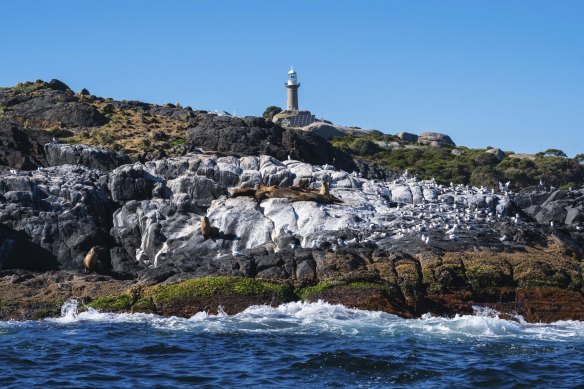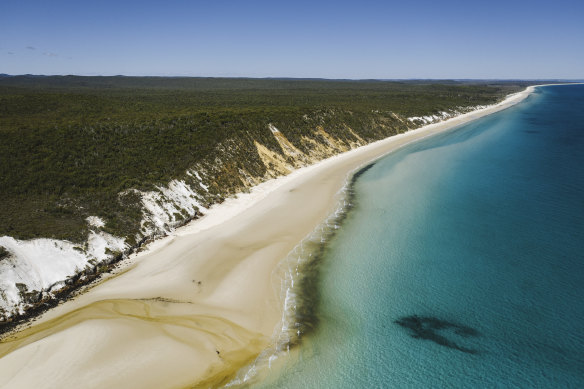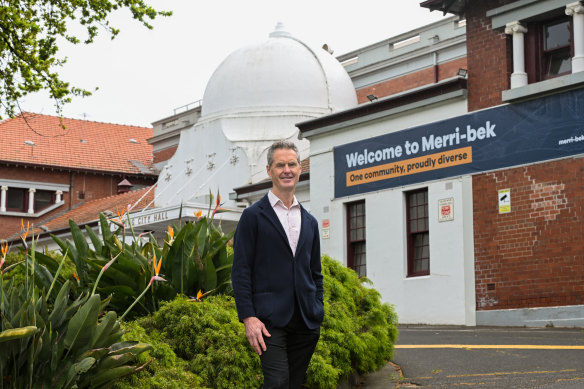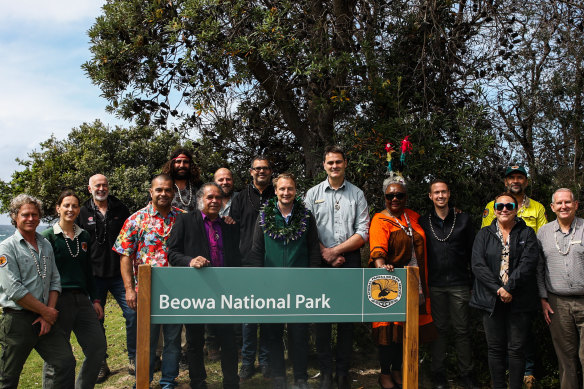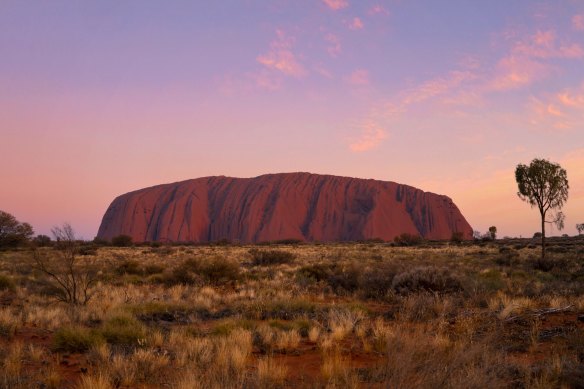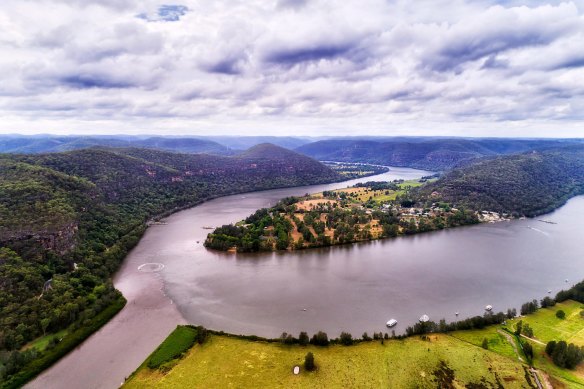Part of Blue Mountains next spot to reclaim its Indigenous name as trend picks up

Save articles for later
Add articles to your saved list and come back to them any time.
What’s in a name? Quite a lot, if the furore around the growing trend for using Indigenous place names is to be believed.
State geographical naming bodies are wading through a flood of applications for formal recognition of Indigenous places, and in many cases local councils, businesses and sporting bodies have just gone ahead and began to promote Indigenous place names. Montague Island, off Narooma on the NSW south coast, was formally given the dual name Barunguba last week.
Montague Island now has an additional official name, Barunguba.Credit: Eurobodalla Coast Tourism
“It makes us proud when we hear our language being spoken and the community calls landscape by its original name we have been using for tens of thousands of years,” said Danny Chapman, chair of the NSW Aboriginal Land Council and a Yuin man. “Dual naming is a powerful way of healing country, protecting our culture, and connecting community. It also plays an important role in truth-telling as we walk the path of reconciliation together.”
Tourist icon Cape Byron is also undergoing a process likely to result in the dual name of Walgun, and Mount Canobolas near Orange in central west NSW will be formally given the dual name Gaanha-bula on Saturday, acknowledging the views of the Wiradjuri traditional owners. Next week, the NSW Geographical Names Board will consider attaching the Indigenous name Gulu-mada to a section of the Blue Mountains.
But a conservative backlash is underway. Last month a news radio report claiming the Queensland government was about to rename Brisbane Meanjin in recognition of the area’s original residents, the Turrbal people, was quickly shown to be false.
Although untrue, the story fed a spate of follow-up news stories and commentary, with One Nation leader Pauline Hanson telling Sky News the non-existent proposal was “ridiculous”.
“How insane is this, to actually want to change the name of Brisbane, that’s been called Brisbane for, what, 150 years plus,” Hanson said. “And we’re going to change it to a name that – I can’t even remember what you said, within a matter of a few seconds – I can’t remember.”
A One Nation spokesman confirmed that the party did not just oppose rare cases of a European name being replaced with a traditional Indigenous name – such as the former Fraser Island being renamed K’gari in June after a long campaign by traditional owners, the Butchulla people. It also opposes the much more common use of dual names, in which a traditional Indigenous place name features on official signage alongside a European name, such as the formal use of Naarm for central Melbourne or Warrane for Sydney Cove by local councils.
K’gari will no longer be known as Fraser Island as a result of lobbying by its traditional owners.
“It doesn’t achieve anything, it doesn’t address Indigenous disadvantage, it doesn’t address real problems,” a One Nation spokesman said. “On top of that the vast majority of Australians will continue to use the original [English] name – the community sentiment is against it.”
Professor Nicholas Evans, an Australian National University specialist in Indigenous languages, said place names touched a nerve because they were an assertion of power. “It’s a common problem across the world – different cultures wrestle for control of language, and the person who gets to choose the name is the boss,” he said. “In basic terms, anytime a country conquers another country, they rename things. Then people try to wrestle control back again. An example is Ukraine, where the name of the capital was changed from Kiev, which is derived from the Russian language, to Kyiv, which is Ukrainian. It’s a subtle difference, but it’s important because it says ‘this is our country’.”
While the linguistic power struggle can antagonise both sides of the debate, Evans said using Indigenous place names alongside European names played a practical role. “It may seem like a small thing but it’s part of a bigger national project. Having names side by side on a sign is a simple but effective way of saying that there are different cultures here, different interpretations of history and we respect that,” he said. “My sense is that more and more people are making the shift towards curiosity, towards finding out more about Indigenous culture in their region.”
In all states and territories, governments have policies that encourage the use of Indigenous place names. NSW has had a bipartisan view supporting dual naming for two decades, and Victoria and NSW both strongly encourage the use of Indigenous names for new suburbs, bridges and capital works projects.
The NSW Minister for Indigenous Affairs and Treaty, David Harris, said he believed the government’s dual-naming policy had broad community support. “As I see it, it’s about building more meaning, and being accepting of everything that’s happened, rather than having a narrow view of history,” Harris said. “We’ve got to acknowledge the good, bad and ugly. We’re an interesting, multicultural place, and it’s a good thing when our place names reflect that.”
“Then there is the tourism angle – the surveys show that 85 per cent of international tourists that come here want to engage with Indigenous culture, learn about songlines and stories.”
Merri-bek Mayor Mark Riley at Coburg Town Hall on the day the council changed its name.Credit: Justin McManus
A minority of name changes are driven by a view that an existing European name is inappropriate. Merri-bek Council in northern Melbourne received 6315 survey responses when it floated the idea of changing its name from Moreland – a name which commemorated a Jamaican slave estate. Only 6 per cent of those who responded wanted to keep the old name.
There was similar strong support when Beowa National Park on the NSW south coast changed its name from Ben Boyd National Park – a reference to a pastoralist who also practiced slavery. Yet Ben Boyd Road in Sydney’s Neutral Bay retained its name last year after a council survey found 54 per cent of respondents wanted it to stay as it was.
The national park previously named in honour of Ben Boyd was completely renamed as a result of Boyd’s links to slavery.
“The passion people have about place names and connection to their country comes through in the submissions we receive every day,” said Narelle Underwood, chair of the NSW Geographical Names Board, the 25th Surveyor-General of NSW and the first woman to hold the role.
“We always have to balance a range of views and test the arguments and then take it back to the public for consultation, so the process can take quite a while,” she said.
Underwood said that in her experience, once the newness had worn off, people tended to appreciate the addition of a new name. “I think the most famous one Australians can lean on is [changing] Ayers Rock to Uluru.”
Uluru has been accepted as the name of the geographical feature once better known as Ayers Rock.Credit: Global Headquarters
The board is set to meet on Tuesday and one item on its agenda is the introduction of the local Indigenous name Gulu-mada for a large region of the Blue Mountains.
That proposal arose from the detective work of sleuths at the Dyarubbin project, a collaborative research effort studying Indigenous history of the Hawkesbury River, north-west of Sydney.
In 2017, historian Grace Karskens was scrolling through a microfiche at the State Library of NSW as part of her research for a book on the area’s past and came across a previously unknown document written in 1829 by a Presbyterian minister named John McGarvie. It detailed 178 Indigenous names for culturally significant places in the district, compiled from interviews with traditional owners, bringing to light knowledge that had been thought lost for over a century.
“I’d been working on the book for years and this kind of research can be really boring, page after page,” said Karskens, an emeritus professor at the University of NSW. “Then bang! This amazing document. I thought I was dreaming.”
The major research project, comprising a mix of Indigenous and non-Indigenous specialists, has been able to restore Indigenous names to dozens of sites along the Hawkesbury region. As a result, we now know that the area now known as Richmond township was once called Marrengorra, Windsor was Bulyayorang and Sackville was Dorumbolooa.
Encouragingly for Karskens, some of the place names she and her colleagues dug up in their research have already flowed into local discourse. “I was down at Wisemans Ferry and there was a poster up for a festival at Wulu-marrang,” Karskens said, recognising the name from McGarvie’s list that referred to a low-lying area beside the curve of the river. “Nobody had told them to use the Indigenous name, they just did it and people knew where it was and where to go. It’s just happening naturally and I think that’s wonderful.”
The Wisemans Ferry site where the Indigenous name Wulu-marrang has fallen into local use without official prompting.Credit: Taras Vyshnya / Alamy Stock Photo
The Morning Edition newsletter is our guide to the day’s most important and interesting stories, analysis and insights. Sign up here.
Most Viewed in National
From our partners
Source: Read Full Article
